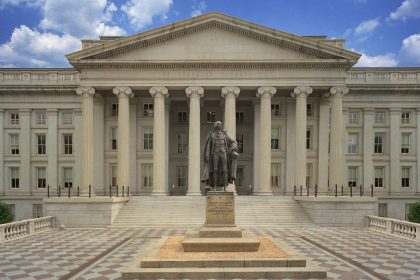Olga Rolenko/Getty Images
Key takeaways
- A crypto winter is a prolonged period of declining crypto prices and low trading volume, along with an overall decrease in investor sentiment.
- Crypto winters can be caused by a number of factors, like rising interest rates, other macroeconomic shifts or major market manipulations.
- One of the most prominent crypto winters to occur was in 2022, when the industry lost more than $1 trillion in market value.
- Predicting when a crypto winter will start or end is almost impossible, but you can prepare by staying diversified and only investing what you can afford to lose.
Crypto markets experienced a sharp decline recently, with the total market cap falling nearly 35 percent from mid-December 2024 to mid-April 2025. While the crypto market has since bounced back, the downturn sparked fears of a crypto winter — a prolonged period of declining prices, low trading volume and decreased investor sentiment in the crypto market.
But what exactly causes a crypto winter, and what does it entail?
Here’s how to identify one, some background on the 2022 crypto winter and how investors can prepare for future crypto downturns.
What causes a crypto winter?
The term crypto winter was first used in 2018 when Bitcoin crashed and the crypto market experienced a long period of low prices and low trading volume. Some typical markers of a crypto winter include decreased market prices, overall market value decreases and negative investor sentiment.
A crypto winter can be triggered by a number of factors, including macroeconomic shifts (interest rate hikes), speculative bubbles bursting and major market manipulations or scandals.
Here are some other key factors that may lead to a crypto winter, or in some cases, make one worse:
- Decreased interest from institutional investors: Institutional investors have played a key role in contributing to the success of major cryptocurrencies such as Bitcoin and Ethereum. However, if they perceive that cryptocurrencies have started to decline or stagnate, they may become hesitant to participate in the market, leading to a decline in asset values.
- Oversaturation in the market: Cryptocurrencies that do not have a strong business plan or a unique value proposition may not be able to survive in the market long-term. As the coin market becomes more competitive, it’s harder for new coins to stand out.
- Major security breaches, hacks and fraud: Major cybersecurity issues and fraud can shake investor confidence in crypto networks. For instance, in 2014, Bitcoin lost nearly $500 million in value after Mt. Gox, a Tokyo-based exchange, filed for bankruptcy. Mt. Gox had a number of cybersecurity issues that prevented Bitcoin withdrawals from being processed.
- Unclear regulations: Cryptocurrencies and blockchain technology have both faced regulation hurdles since they were first introduced to the market. As government oversight has tightened, lawsuits and regulatory actions have increased and put a damper on crypto hype.
Bear market vs. crypto winter
While the terms bear market and crypto winter are often used interchangeably in the crypto world, they aren’t exactly the same, although a bear market and crypto winter can happen concurrently. A crypto winter refers to a period when stocks and currencies in the crypto world lose popularity and value, becoming stagnant. A bear market occurs when the price of a financial asset declines 20 percent or more off a recent market high.
The 2022 crypto winter
The 2022 crypto winter was triggered, in part, by high inflation rates in the U.S., leading to aggressive interest rate increases by the Federal Reserve. Other major contributing factors included:
- The collapse of Luna and TerraUSD cryptocurrencies in May 2022, which plummeted Bitcoin to its lowest price since 2020.
- Three Arrows Capital, a crypto hedge fund that managed about $10 billion in assets at its peak, also crashed due to its investments in coins that collapsed.
- The bankruptcy and collapse of FTX in November 2022, following reports that the cryptocurrency exchange had mismanaged customer funds.
Overall, the industry erased more than $1 trillion from the market in 2022, according to the New York Times. According to CoinGecko’s 2022 Annual Cryptocurrency Industry Report, the combined value of the top 100 cryptocurrencies was around $830 billion on Nov. 14, 2022, a significant decrease from the $2.7 trillion market cap observed on Nov. 7, 2021. The decline in prices was widespread, and while the market gained ground in 2023, it didn’t reach the previous highs of 2021 and 2022 until late 2024.
How to prepare for a crypto winter
Predicting when a crypto winter will start or end is extremely similar to trying to predict how high a cryptocurrency asset will go during a bullish period (when prices rise by 20 percent or more). It’s nearly impossible to know for certain, but if you’re willing to withstand the risk and volatility of crypto, you can still try.
“Because crypto prices are based only on trader sentiment, it’s impossible to predict how high or low they’ll go,” says James Royal, Bankrate’s principal investing writer. “So it’s especially important to mitigate your overall risk by never trading with money that you can’t afford to lose. For example, keeping your overall stake in crypto to a few percent of your total investment portfolio ensures that even a total wipeout doesn’t affect your overall wealth too much.”
Similar to strategies used in traditional stock markets to survive a bear market, there are ways for investors to navigate through a crypto winter.
- Stay updated with cryptocurrency news: Keep your finger on the pulse of what’s happening through industry news channels, Discord servers, social media and trusted investing publications.
- Monitor investor sentiment: Check how crypto is trading by monitoring popular exchanges.
- Look beyond crypto: Consider diversifying your investments outside of the crypto space and trying strategies such as dollar-cost averaging and risk management.
“Because their price is driven by sentiment, cryptocurrencies that have shown greater resiliency, such as Bitcoin and Ethereum, may end up performing better than unknown coins,” says Royal.
Bottom line
Crypto winter is a period of prolonged decline in the cryptocurrency industry that can be difficult to predict and navigate. However, investors can still prepare themselves for the future by staying updated with cryptocurrency news and monitoring investor sentiment, as well as diversifying their investments.
Note: Former Bankrate editor Nina Semczuk contributed to a previous version of this article.
Read the full article here
















